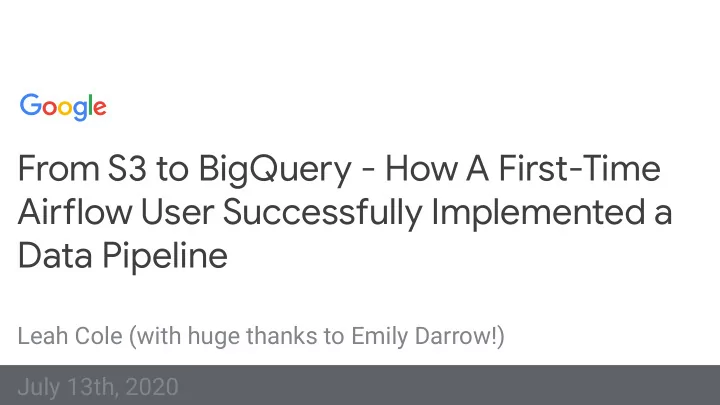

From S3 to BigQuery - How A First-Time Airglow User Successfully Implemented a Data Pipeline Leah Cole (with huge thanks to Emily Darrow!) @leahecole July 13th, 2020
Intro to Leah @leahecole
Today's Story • Prologue • Chapter 1: BigQuery Public Datasets • Chapter 2: Growing Pains • Chapter 3: The Goal • Chapter 4: The DAG • Epilogue • Q&A @leahecole
Prologue @leahecole
Intro to Composer Note: not all Composer components are depicted in the diagram (others were highlighted in a @leahecole presentation last week from Rafał Biegacz)
UNIQUE Google Cloud’s enterprise data Fully managed and serverless warehouse for analytics for maximum agility and scale UNIQUE Google Gigabyte to petabyte scale Real-time insights BigQuery storage and SQL queries from streaming data UNIQUE Encrypted, durable, Built-in ML for out-of-the-box And highly available predictive insights UNIQUE High-speed, in-memory BI Engine for faster reporting and analysis @leahecole
BigQuery: architecture Serverless. Decoupled storage and compute for maximum fmexibility. SQL:2011 Compliant BigQuery Replicated, High-available REST API Streaming ingest distributed storage cluster compute (99.9999999999% durability) (Dremel) Distributed Web UI, CLI memory shuffme tier Client libraries In 7 languages Petabit network Free bulk loading @leahecole
Chapter 1: BigQuery Public Datasets @leahecole
You need to... Discover the dataset and where to access it. Negotiate access to the dataset. Understand the dataset, how it can be joined with your data, and its changes. Load the data into your systems. The "Data Science" method Update, maintain, and secure your data and database. Manage access and keep the data updated. Link public data with private data. Analyze , Visualize and communicate your results. @leahecole
You need to... Discover the dataset and where to access it. Negotiate access to the dataset. Understand the dataset, how it can be joined with your data, and its changes. Load the data into your systems. What if you only did this? Update, maintain, and secure your data and database. Manage access and keep the data updated. Link public data with private data. Analyze , Visualize and communicate your results. @leahecole
Current catalog Data providers: >180 datasets Onboarded and maintained by Googler(s) with data provider input/guidance g.co/cloud/marketplace-datasets @leahecole
Chapter 2: Growing Pains @leahecole
Growing Pains in the Public Datasets Program Understand the dataset, how it can be joined with your data, and its changes. Load the data into your systems. @leahecole
Late 2019: Onboarding a New Dataset • New dataset comes in • Temporarily stored • Perform transformations • Ends up in BQ @leahecole
Late 2019: Problems with Current Process • Disparate data sources + formats • Internal/external resource communication • Access control inconsistent • Tooling • Transformations • Manual @leahecole
Chapter 3: The Goal @leahecole
The Goals • Unified, repeatable process • Utilize GCP products designed for this • Hopefully open source process • See process through eyes of first-time Airflow user (Leah + Emily) @leahecole
Early 2020-Present: Proposed solution 1. Clone repo, 2. Add config + transformations 3. Generate DAG + .tf config make branch YAML config Custom transformations 5. Presubmit checks 6. Human review 7. Deploy 4. Create a PR @leahecole
Chapter 4: The DAG @leahecole
The DAG Development Process • Shared repo • Shared GCP project • Leah + Emily both owners • Shared notes • Meetings • Pairing as needed • Regular team meetings @leahecole
DAG version 0.0 • Get data from S3, store in GCS • Make target dataset • Put data into BigQuery Problem: • Leftover GCS bucket @leahecole
DAG version 0.1 • Get data from S3, store in GCS • Make target dataset • Put data into BigQuery • Delete staging bucket @leahecole
DAG version 1.x - Schema Defjnition, Resource Creation @leahecole
DAG version 1.x - YAML confjg @leahecole
DAG version 1.x - Verify @leahecole
DAG version 1.x - Verify @leahecole
DAG version 1.x - Extract @leahecole
DAG version 1.x - Transform + Load @leahecole
Epilogue @leahecole
Lessons Learned • Double check your Composer and Airflow versions • Documentation is extremely important • Changelogs and release notes are extremely important • Transferring data between cloud providers is REALLY easy with Airflow @leahecole
Call to Action • Contribute • Automate • Collaborate @leahecole
Thank you to • Emily Darrow - for their technical legwork with this project • Tim Swast - technical advice + vision, moral support • Shane Glass - technical advice, vision, and presentation content • Rafał Biegacz + the Composer Team - presentation content + tireless engineering work • Seth Hollyman and my Data Analytics DevRel colleagues - presentation content, moral support, and constant inspiration • Moderators, sponsors, and attendees! @leahecole
Q&A with Leah, Tim, and Shane @leahecole
Recommend
More recommend